South Carolina is known as a beautiful coastal state with a very diverse geography and animal life. Its natural regions are covered mainly by the Atlantic Coastal Plain, along with sandhills, flat farmland, rivers, and swamps. As such, the state has a number of state animals, from the white-tailed deer to the Carolina wren.
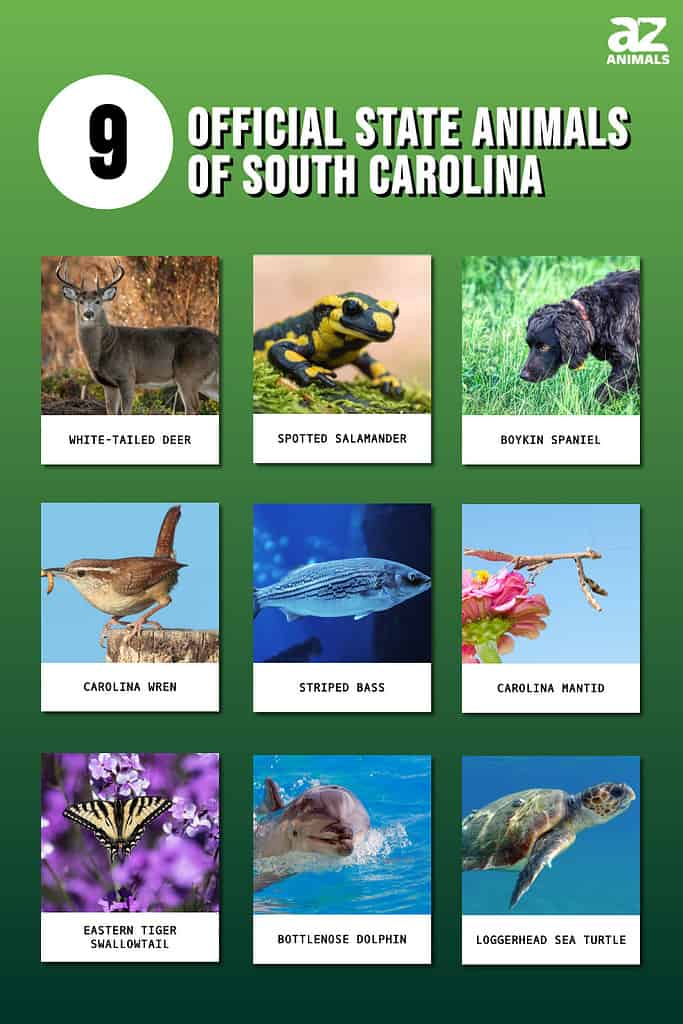
Let’s take a look at nine of South Carolina’s state animals and why they are so important to the ecosystem of the Palmetto State!
South Carolina State Animal: White-Tailed Deer
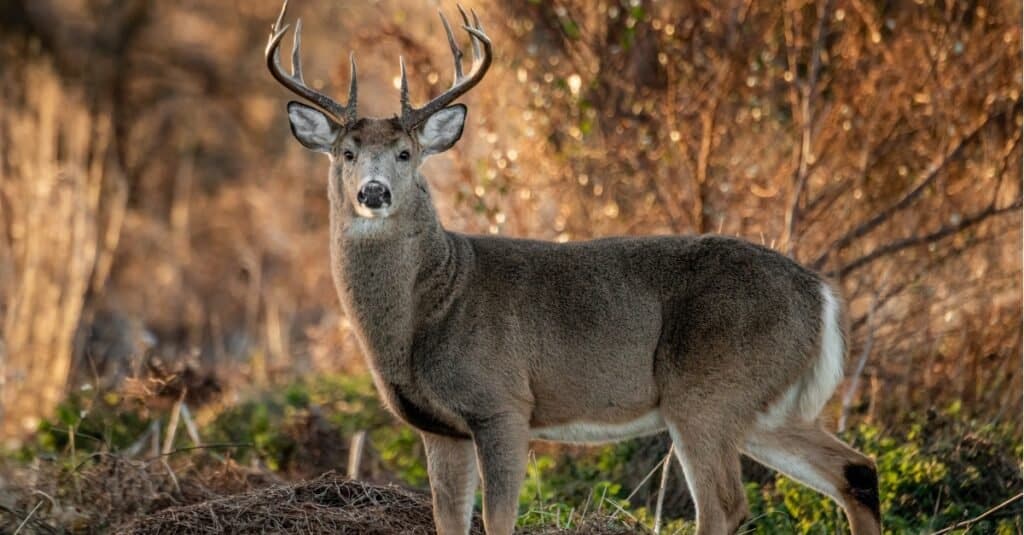
The white-tailed deer (pictured) has a more red tint to it in the warmer months.
©iStock.com/Harry Collins
Species Name: Odocoileus virginianus
Except for two or three states in the west, white-tailed deer are found throughout most of southern Canada and the entire continental United States. Naturally, they are also found in North Carolina. Their range also extends from Bolivia through all of Central America.
The white-tailed deer is an exceptionally beautiful creature. It has a white tail that is 11 inches long and a body length of around 78 inches. While the gradation of its dorsal hue varies regionally, seasonally, and across subspecies, it is generally grayer in the winter and redder in the summer. White fur can be found on the top insides of the legs, in a band behind the snout, in rings around the eyes, inside the ears, over the chin and throat, and under the tail.
Whitetail deer can live in a range of terrestrial settings, including Florida’s hammock swamps and dense sawgrass, as well as the vast forests of northern Maine. Just as well, they live in brushy areas and other remote western regions like the cactus and thornbush deserts of southern Texas and Mexico. Dense thickets with sandy borders provide the ideal whitetail deer habitat.
South Carolina State Amphibian: Spotted Salamander
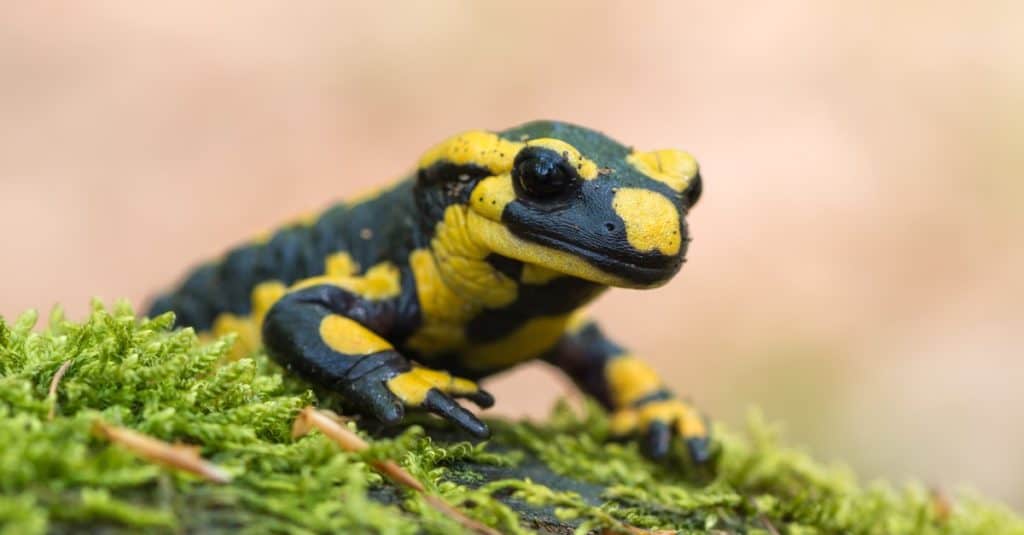
This
salamander
is a black and yellow-spotted Fire Salamander.
©Marek R. Swadzba/Shutterstock.com
Species Name: Ambystoma maculatum
Eastern North America is where spotted salamanders thrive in the wild. Their range reaches southern Georgia and eastern Texas in the south and western shores of Lake Superior in the east. They are widespread in South Carolina as well.
The overall length of an adult spotted salamander is 10 inches, with females often being bigger than males. The body is substantial compared to other salamanders, and the nose is broadly shaped. The rear of the jaw is puffy on the sides of the skull. Four to five toes are seen on the robust, big legs of this species. And, of course, they have black bodies with big orange-yellow spots throughout.
Adult spotted salamanders can be found in highland mixed or coniferous woods provided the environment is suitably wet and breeding ponds are present. However, deciduous bottomland forests around rivers are where they are most commonly found. Because they spend the majority of their time under leaf litter, under fallen wood, or in underground tunnels, adults are rarely observed in the wild and are hard to find. Spotted salamanders only lay their eggs in ponds and pools that lack fish, as the majority of salamander species do.
South Carolina State Dog: Boykin Spaniel
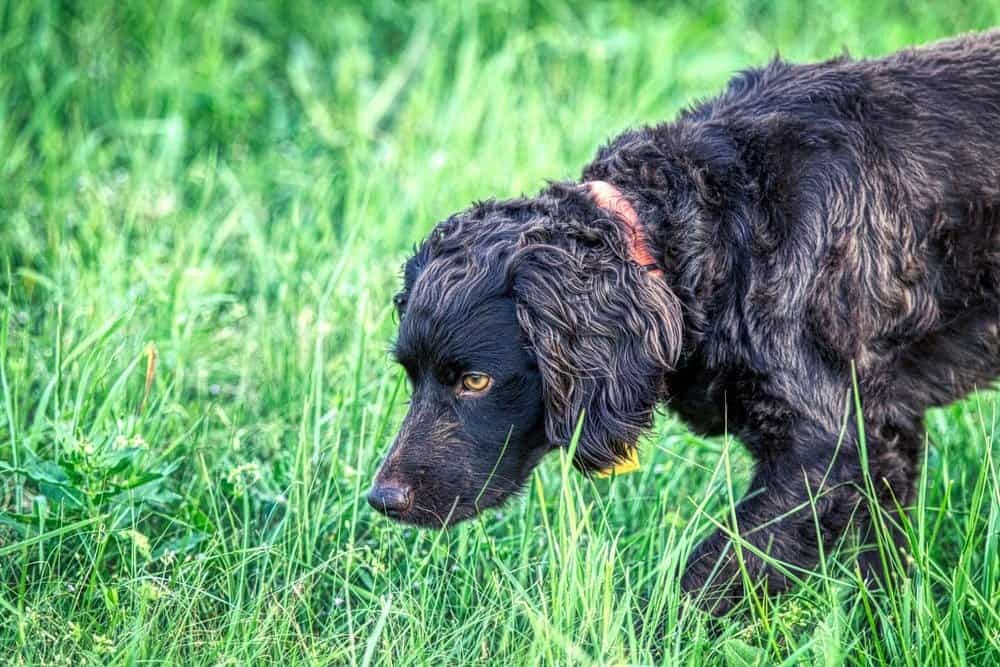
The Boykin Spaniel (pictured) is a popular hunting or companion dog in South Carolina.
©Cynthia Davison/Shutterstock.com
Species Name: Canis familiaris
The Boykin Spaniel was bred by South Carolina hunters as the ideal canine for duck and wild turkey hunting in the Wateree River Swamp in the early 1900s. It is a medium-sized, tough dog that could retrieve on both land and water. In those days, hunters had access to the game-rich river corridors through carts, wooden boats, and railroads. However, what hunters could take was constrained by boat transport space. The standard heavyweight retriever was a disadvantage aboard a ship already packed with crew, weapons, supplies, and other equipment. Hence, the Boykin Spaniel became the perfect alternative.
The Boykin Spaniel is a medium-sized dog that grows to a length of around 17 inches. Because of the large range of breeds that make up this breed’s recent ancestry, coat length and density can vary greatly. The hair is medium in length, fine, and flat to somewhat wavy; on the legs, feet, ears, chest, and belly, light feathering is appropriate. The body’s length is typically between one and two inches. They are a deep, coffee brown in color and often boast floppy copper-hued ears.
South Carolina State Bird: Carolina Wren

Carolina wrens are modest in size but when compared to other wrens, are quite large.
©Steve Byland/Shutterstock.com
Species Name: Thryothorus ludovicianus
The southeastern United States, especially South Carolina, is home to Carolina wrens all year long. This species’ range extends from the Atlantic coast all the way to Texas, Nebraska, Kansas, and eastern Oklahoma in the west. Southern Michigan, New York, and Massachusetts form its northern borders.
While modest in size, Carolina wrens are huge in comparison to other wrens. They are roughly five inches long and weigh around a quarter ounce. Carolina wrens have an unbarred, lighter cinnamon-colored underbelly and a rich rusty-brown back. The wings, tail, and undertail are banded black, while the neck and chin are white. Carolina wrens can be distinguished from other wren species by their unusual colors and a characteristic broad white stripe over each eye.
Carolina wrens can be found in a broad range of habitats, including swampy woods and brushy clear-cuts in South Carolina. A favored habitat type is moist woods, and a crucial habitat need is moderate to thick shrub or brushy cover.
South Carolina State Fish: Striped Bass

Striped bass can grow to a length of six feet and weigh as much as 100 pounds or more.
©slowmotiongli/Shutterstock.com
Species Name: Morone saxatilis
The striped bass is a large predatory fish with black stripes running down its metallic sides. It is also known as the rockfish. The Chesapeake Bay and its tributaries are home to a portion of the Atlantic Coast’s year-round population. Many states, including South Carolina, have it as their official state fish.
Striped bass can grow to a length of six feet. They can easily weigh as much as 100 pounds or more. Adult striped bass typically reach three feet and weigh around 20 pounds. Its metallic sides are striped with seven or eight dark, continuous lines, and the color of its elongated body ranges from light or olive green to blue, brown, or black. They have white bellies. They also have three spines on their rear fin and a black, forked tail fin.
Many tiny fish and invertebrates, like worms, squid, and anchovies, are consumed by striped bass as food. Sharks, large fish, and fish-eating birds are examples of the striped bass’s predators.
South Carolina State Insect: Carolina Mantid
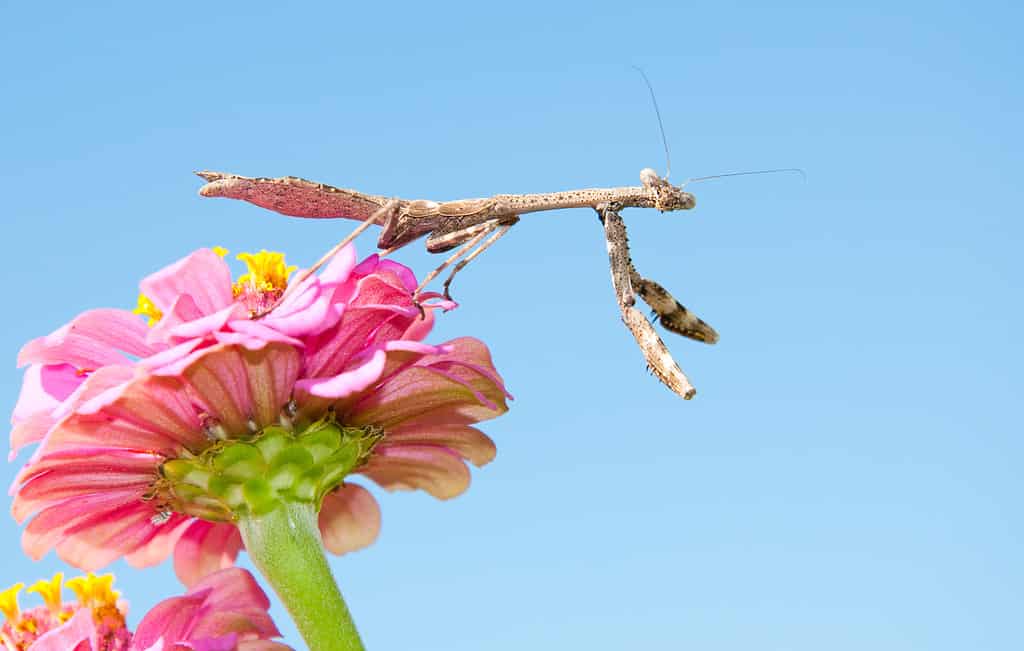
The Carolina mantid is a cannibalistic species.
©Sari ONeal/Shutterstock.com
Species Name: Stagmomantis carolina
In South Carolina’s natural environments, the Carolina mantid is a very common insect predator. North America is home to this species, which is notably prevalent in the southern states from New Jersey to Florida.
These insects have a length of roughly two to three inches and a wide range of colors. They might be brown, brown with bands or spots, green, green with spots, or grey with spots. Typically, this insect has its front legs folded in front of it in a position simulating a prayerful posture. The mantid’s forelegs reach out, seize its victim when it approaches too closely, and hold it in place until it finishes consuming it.
Carolina mantids molt and develop during the summer, gaining wing buds with each subsequent molt. By the time they reach maturity in the late summer, their wings are completely developed. Carolina mantids are cannibalistic, as are similar species. Females occasionally eat their male companions both during and right after mating.
South Carolina State Butterfly: Eastern Tiger Swallowtail
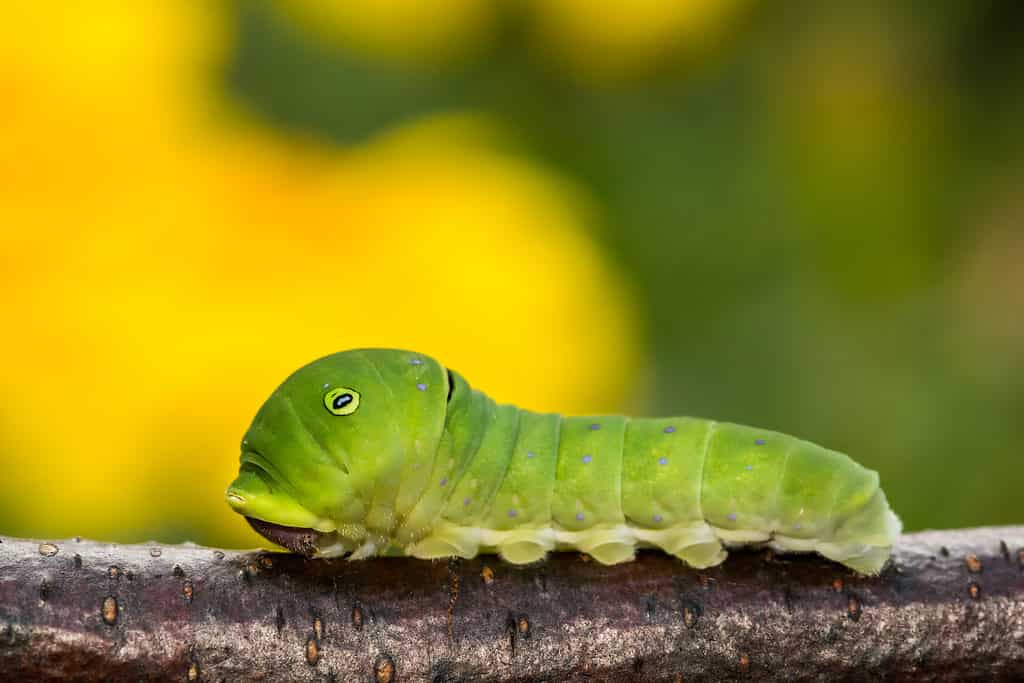
The Eastern Tiger Swallowtail
caterpillar
(pictured) is recognized by its false “eyes” behind its head.
©Jay Ondreicka/Shutterstock.com
Species Name: Papilio glaucus
The Eastern Tiger Swallowtail is a stunning, large butterfly that often measures five inches across. It may be recognized by its yellow body and black tiger stripes. Female Eastern Tiger Swallowtails can be either yellow or black, but males are usually yellow. Males lack the iridescent blue wash that females have on their tails. South Carolina produces two to three broods each year. The majority of the United States and Canada are included in its breeding range.
Eastern Tiger Swallowtails are frequently spotted soaring in the air over woodlands, deciduous trees, and surrounding streams. They also dwell in parks, orchards, and residential gardens. They often get together at places where there are many wildflowers to congregate and enjoy a variety of blooms.
An extensive range of host plants is used by the Eastern Tiger Swallowtail. While they are larvae, they prey mostly on cottonwood, ash, cherry, tulip tree, willow, and sweet bay trees. The nectar of milkweed, thistles, and honeysuckle is consumed by adult butterflies. As mature butterflies, they only live for around two weeks.
South Carolina State Marine Mammal: Bottlenose Dolphin

Bottlenose dolphins attach a sponge to their noses and use it to protect their flesh while foraging for food.
©iStock.com/Lefteris_
Species Name: Tursiops truncatus
In general, bottlenose dolphins live in seas with surface temperatures of 50 to 90 degrees F. While some bottlenose dolphins move periodically, they are normally found off the coast of South Carolina in tropical, subtropical, and warm temperate waters.
The fusiform bodies of bottlenose dolphins lack numerous external features of terrestrial animals, such as hair, external ears, and rear limbs. Bottlenose dolphins can cruise underwater at great speeds thanks to their fusiform bodies, which also lessen turbulence. Dolphins can swim thanks to their front flippers, dorsal fin, and flukes. The dorsal fin is situated close to the center of the back and is tall and curved. These dolphins’ sides are typically black to light gray, and their bellies are typically white, occasionally with a faint pink tint.
Except for polar seas, bottlenose dolphins are found all around the world. While inshore bottlenose dolphins breathe twice every minute, deep-water bottlenose dolphins come up to the surface once or twice each hour. Bays, estuaries, sounds, wide shorelines, and broad, estuary rivers are all places where bottlenose dolphins may be found.
South Carolina State Reptile: Loggerhead Sea Turtle
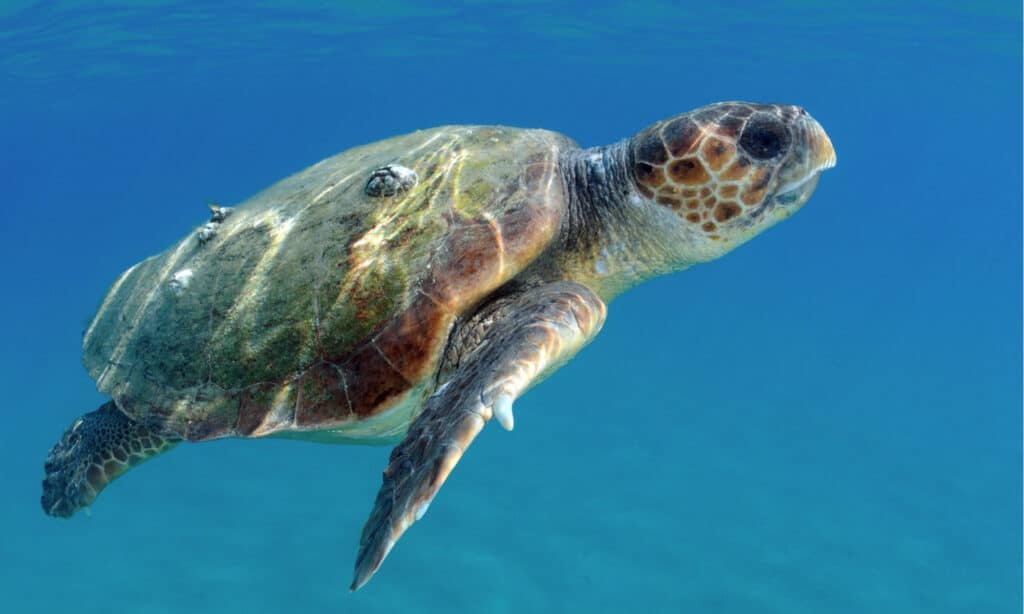
Loggerhead turtles are one of the largest living hard-shelled sea turtles.
©Matteo photos/Shutterstock.com
Species Name: Caretta caretta
Nearly all temperate and tropical areas of oceans on Earth are home to loggerhead sea turtles. These can also be seen on the South Carolina coast.
One of the largest living hard-shelled sea turtles found today are loggerhead turtles, so named for their enormous heads and strong jaws. They have a carapace that resembles a heart and is usually covered in commensal organisms like barnacles and algae.
Over its life cycle, the loggerhead sea turtle’s preferred environment varies. Mature females appear to favor steeply sloping, energetic beaches when they come ashore to deposit eggs. Hatchlings go toward the ocean as soon as they leave the nest. In warm water currents, young juveniles are frequently located among floating brown algae mats. Adults and older juveniles are often found along coasts, and they choose a rock-covered or muddy ground over one that is sandy.
How cool are these South Carolina state animals? Few states have state butterflies and state marine mammals, which makes this state’s list of official state animals quite unique!
The photo featured at the top of this post is © Ray Hennessy/Shutterstock.com
Thank you for reading! Have some feedback for us? Contact the AZ Animals editorial team.






